| Issue #39 • May/June, 1996 |
A huge brown beast stared at me as I drove through our apple orchard toward the house. I parked, walked quickly into the house, and said to my husband, “Tom’s bull is munching on our apple trees.”
He shot past me out the door, yelling, “Call Tom and tell him to get over here now!”
The next half hour was spent running this way and that. We chased south and withdrew to the north. We herded south and blocked on the east and west. Finally the bull, several cows, and one fat sheep were escorted out of our orchard and into their own pasture. During this process, the bull nonchalantly stepped over a three-foot fence and trampled my garden. Later, while discussing the event with Tom, we decided that we were glad that most of our vegetables, flowers, and shrubbery had been spared. The apple trees were left standing with only minor damage to the foliage and fruit.
This incident was only one of many animal-related problems we had faced since we had become backwoods homeowners. Deer stripped new growth off young fruit trees, cats used vegetable plots for litter boxes, and visiting dogs dashed through flower and vegetable gardens, trampling as they went. Even our own dog loved to dig in planted areas rather than the natural wooded areas. We were frustrated. My husband built fences higher and higher around the orchards. This was useless, as deer can jump amazingly high. I planted shrubs, flowers, and vegetables, only to have them torn up by dogs. The cats loved the freshly worked soil, and rabbits nibbled at what was left. And this was not the first time we had been invaded by bovine beasts. What were we to do?
At first we tried fences. We fenced groups of trees, we fenced islands of flower gardens around the house, and we fenced vegetable plots. We created a botanical zoo with plant cages all over our property. The fences kept the dogs out but did not faze the cats, cows, and rabbits that wandered through. The deer were not even slowed down by the fences, no matter how high we made them. The fences were unsightly and very inconvenient when we were caring for the plants and trees. We became vigilant plant guards, but decided we did not want to dedicate our lives to this pursuit, especially our lives between 10 p.m. and 6 a.m.

Fencing is laid in two sections around a fruit tree. The tree can be watered, fertilized, sprayed and harvested with the wire in place. |
We thought through the problem and came up with a solution. We immediately put into action our “Protect Trees and Plants from Four-Legs Plan,” and very soon we knew we had a plan that worked.
We had used livestock fencing attached to wood and metal stakes for fences. We removed the stakes, cut the wire fencing into workable sizes, and just laid it on the ground in the areas we wanted to protect. Once an animal puts a foot on the wire, it backs up. We were and still are amazed at how well this works.
Our dog will not enter the areas covered with wire, so no more uprooted and trampled plants. No more holes dug under trees. The cats find better areas to scratch, and best of all, the deer keep away from our trees. It is so nice not to have all the new growth eaten off the trees. We have not had a visit from a bull, cow, or sheep since we laid the wire, but we think it will work for them, too. We have found bear spoor in the areas furthest from the house, but our trees and their fruit have remained undamaged. I still see rabbits in the clover surrounding the apple trees and in the native undergrowth, but there have been no holes dug around the wire-protected trees. We have not detected any damage to the fruit trees or the gardens caused by rabbits.
Since we heartily recommend our method to anyone wanting to protect their plant life from four-legged animals without using harsh methods, the rest of this article will provide specific information about it.
Use livestock fencing
A 12- or 14-gauge field fencing works well. It is sturdy and holds up well. It can be cut readily with a wire cutter and is rigid but bendable. There are many kinds, heights, lengths, and hole sizes available. The twisted wire is cheaper and easier to work with than welded wire. My personal favorite is a three-foot-high, 12½ gauge, non-climb fencing that has 2″ x 4″ holes.
Wire fencing can be purchased at feed stores, hardware stores, and garden shops. The price depends upon the gauge, whether it is twisted or welded wire, the size, and the amount. A 330′ roll of twisted wire field fencing with 2″ x 6″ holes at the bottom and 6″ x 6″ holes at the top sells, in my area, for $104. A 100′ x 3′ non-climb 12½ gauge fencing that has 2″ x 4″ holes sells for $85. I saw 50′ x 3′ of 14-gauge welded wire fencing for $23.
Save and reuse previously used wire fencing. There are no definite size requirements for the fencing. We often use whatever is on the scrap pile.
Cut into workable sizes
Get out the wire cutters, pliers, tape measure, and work gloves. Besides the fencing itself, that is all you will need to implement the method. “Workable size” means something that you can handle. This obviously varies from person to person and depends on the size of the area and the plant that is to be protected. You need to remember that you will have to be able to remove the fencing to work the soil. Don’t worry about the size of the pieces if you are using scrap fencing. Just do the best you can with what you have. The wire can be overlapped lying on the ground or joined with a twist of the pliers if need be.
For garden areas:

Sections of fencing can be laid right over small plants |
Roughly measure the area. If the fencing can be cut in one piece, great. If not, cut the fencing into the largest sections possible that will cover the area. However, the pieces should not be so large that you cannot handle them comfortably. Arranging the fencing is discussed below.
For trees and shrubs:
Cut two pieces of fencing, each about 6′ x 3′. It is better to use two pieces rather than one, because it is easier to remove. However, we have sometimes placed one smaller piece of fencing over a newly-planted bare root tree. The wire can always be cut later.
Placing fencing over bare or just-seeded soil is easy. Just lay it down and bend over the ends, poking them into the soil
Care needs to be taken so as not to damage plants when placing the fencing over trees, shrubs, or growing vegetables and flowers. Some cutting will be required to make the fencing fit over or around them. At any cut, poke the wire ends into the ground to secure it and to make it safer for you. Overlap fencing as needed for coverage.
Most watering, fertilizing, spraying, and weed control can be done with the wire in place. After all, people wearing shoes can walk on the wire.
When major work needs to be done, such as harvesting, tilling, or planting, simply lift the wire fencing from the ground and replace it when you are finished working. If you originally cut the wire into sizes that you can handle, removing and then replacing it is very easy to do.
We have been pleased with the results of this method at our house. We hope you will be, too.


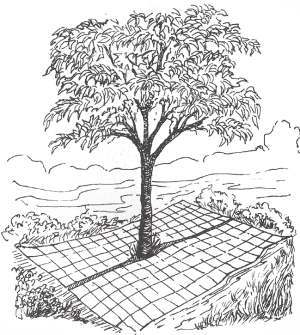

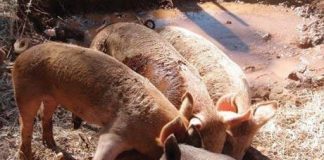




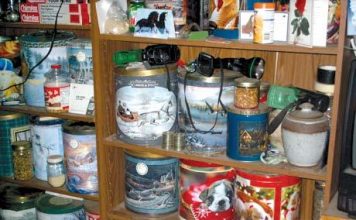

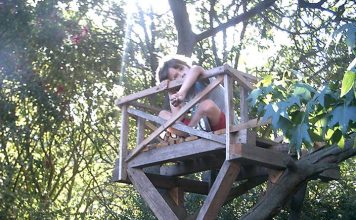
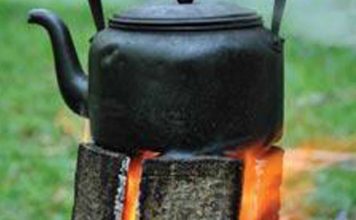


Indoors you can put down aluminum foil to keep your dog away from something. Wouldn’t you want to put down landscaping paper underneath the wire so you don’t have to cut grass around the trees?
Love the idea, but not sure if this would work in areas with snow cover in the winter, when deer pressure is the highest? Maybe elevate a couple feet off the ground?
thank you for posting this. I had tried wrapping my trees but this is a great idea.
Imagine what it would be like to electrify the ground fence area when it may seem necessary, as in the case of the appearance of bear or deer. First, you notice animals close by or in the area being gardened. You turn it on. Big surprise to any animal treading on your hallowed ground. IOWs, it may sometimes get away with trespassing, but how many unlucky chances will wild animals risk after the first experience?
I don’t understand grounding and safety in the grass/weeds in contact with hot fence wire on the ground, but wouldn’t that make your excellent solution much, much better?
sounds like a great option to individual or group fencing; but have you heard about its success with cattle?
How do you cut the grass coming through the fence?
If you do the ground fencing outside a short deer fence you don’t have to bother with fencing plants inside. Duh.